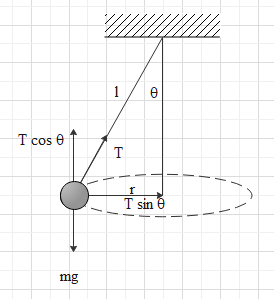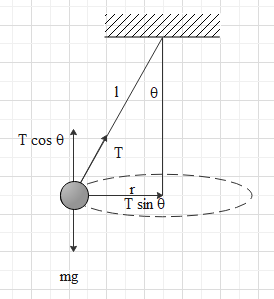
The centripetal force in a conical pendulum of semi vertical angle theta is equal to
A. The horizontal component of tension
B. The vertical component of tension
C. The tension in the string
D. Weight of the bob
Answer
570k+ views
Hint- A conical pendulum consists of a Bob revolving in a horizontal circle with a constant speed at the end of a string. The string makes a constant angle with the vertical so it describes a cone whereas the bob of the pendulum describes a horizontal circle.

Here, $r$ is the radius of the circular path, $\theta $ is the angle between height $h$ and string, $l$is the length of the string, $m$ is the mass of the bob and $\omega $ is the angular velocity of the mass.
The force required to keep an object moving in a circular path is known as centripetal force. This force will be always directed inward towards the centre of rotation.
Step by step solution:
A conical pendulum consists of a Bob revolving in a horizontal circle with a constant speed at the end of a string. The string makes a constant angle with the vertical so it describes a cone whereas the bob of the pendulum describes a horizontal circle.

$r$ is the radius of the circular path, $\theta $ is the angle between height $h$ and string, $l$is the length of the string, $m$ is the mass of the bob and $\omega $ is the angular velocity of the mass.
Here, there are two forces acting on the pendulum, one is due to tension $T$ in the string and the other is due to force of gravity. The tension in the string can be resolved into two components, x component and y component. x component is $T\sin \theta $ and y component is $T\cos \theta $
The force of gravity $mg$ acting downward is balanced by the y component of tension that is $T\cos \theta $ .The necessary centripetal acceleration is provided by the x component of tension $T\sin \theta $.
The force required to keep an object moving in a circular path is known as centripetal force. This force will be always directed inward towards the centre of rotation. This necessary centripetal acceleration required for the motion of the conical pendulum is provided by the x component of tension which is the horizontal component.
So, the answer is option D.
Note: The force required to keep an object moving in a circular path is known as centripetal force. This force will be always directed inward towards the centre of rotation. Don't confuse centripetal force with centrifugal force. Centrifugal force is the force felt by an object moving on a circular path which acts away from the centre.

Here, $r$ is the radius of the circular path, $\theta $ is the angle between height $h$ and string, $l$is the length of the string, $m$ is the mass of the bob and $\omega $ is the angular velocity of the mass.
The force required to keep an object moving in a circular path is known as centripetal force. This force will be always directed inward towards the centre of rotation.
Step by step solution:
A conical pendulum consists of a Bob revolving in a horizontal circle with a constant speed at the end of a string. The string makes a constant angle with the vertical so it describes a cone whereas the bob of the pendulum describes a horizontal circle.

$r$ is the radius of the circular path, $\theta $ is the angle between height $h$ and string, $l$is the length of the string, $m$ is the mass of the bob and $\omega $ is the angular velocity of the mass.
Here, there are two forces acting on the pendulum, one is due to tension $T$ in the string and the other is due to force of gravity. The tension in the string can be resolved into two components, x component and y component. x component is $T\sin \theta $ and y component is $T\cos \theta $
The force of gravity $mg$ acting downward is balanced by the y component of tension that is $T\cos \theta $ .The necessary centripetal acceleration is provided by the x component of tension $T\sin \theta $.
The force required to keep an object moving in a circular path is known as centripetal force. This force will be always directed inward towards the centre of rotation. This necessary centripetal acceleration required for the motion of the conical pendulum is provided by the x component of tension which is the horizontal component.
So, the answer is option D.
Note: The force required to keep an object moving in a circular path is known as centripetal force. This force will be always directed inward towards the centre of rotation. Don't confuse centripetal force with centrifugal force. Centrifugal force is the force felt by an object moving on a circular path which acts away from the centre.
Recently Updated Pages
Master Class 12 Business Studies: Engaging Questions & Answers for Success

Master Class 12 Economics: Engaging Questions & Answers for Success

Master Class 12 English: Engaging Questions & Answers for Success

Master Class 12 Maths: Engaging Questions & Answers for Success

Master Class 12 Social Science: Engaging Questions & Answers for Success

Master Class 12 Chemistry: Engaging Questions & Answers for Success

Trending doubts
What is meant by exothermic and endothermic reactions class 11 chemistry CBSE

Which animal has three hearts class 11 biology CBSE

10 examples of friction in our daily life

One Metric ton is equal to kg A 10000 B 1000 C 100 class 11 physics CBSE

1 Quintal is equal to a 110 kg b 10 kg c 100kg d 1000 class 11 physics CBSE

Difference Between Prokaryotic Cells and Eukaryotic Cells




